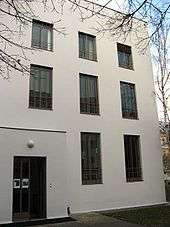Haus Wittgenstein



Haus Wittgenstein, (also known as the Stonborough House and the Wittgenstein House) is a house in the modernist style designed and built on the Kundmanngasse, Vienna, by the Austrian architect Paul Engelmann and the Austrian philosopher Ludwig Wittgenstein.
In November 1925, Wittgenstein's sister Margaret Stonborough-Wittgenstein commissioned Engelmann to design and build a large townhouse. Margaret also invited her brother to help with the design in part to distract him from an incident that had happened while he had been a primary school teacher: he had hit a boy for getting an answer wrong and the boy had collapsed. The architect was Paul Engelmann, someone Wittgenstein had come to know while training to be an artillery officer in Olomouc.[1] Engelmann designed a spare modernist house after the style of Adolf Loos: three rectangular blocks. Wittgenstein showed a great interest in the project and in Engelmann's plans and poured himself into the project for over two years. He focused on the windows, doors, door knobs, and radiators, demanding that every detail be exactly as he specified, to the point where everyone involved in the project was exhausted. One of the architects, Jacques Groag, wrote in a letter: "I come home very depressed with a headache after a day of the worst quarrels, disputes, vexations, and this happens often. Mostly between me and Wittgenstein."[2] When the house was nearly finished he had a ceiling raised 30 mm so the room had the exact proportions he wanted.[3]
Waugh writes that Margaret eventually refused to pay for the changes Wittgenstein kept demanding, so he bought himself a lottery ticket in the hope of paying for things that way.[2] It took him a year to design the door handles, and another to design the radiators. Each window was covered by a metal screen that weighed 150 kg, moved by a pulley Wittgenstein designed. Bernhard Leitner, author of The Architecture of Ludwig Wittgenstein, said of it that there is barely anything comparable in the history of interior design: "It is as ingenious as it is expensive. A metal curtain that could be lowered into the floor."[3]
"I am not interested in erecting a building, but in [...] presenting to myself the foundations of all possible buildings."
—Ludwig Wittgenstein[4]
The house was finished by December 1928, and the family gathered there that Christmas to celebrate its completion. Describing the work, Ludwig's eldest sister, Hermine, wrote: "Even though I admired the house very much, I always knew that I neither wanted to, nor could, live in it myself. It seemed indeed to be much more a dwelling for the gods than for a small mortal like me".[3] Paul Wittgenstein, Ludwig's brother, disliked it, and when Margaret's nephew came to sell it, he reportedly did so on the grounds that she had never liked it either.[2] Wittgenstein himself found the house too austere, saying it had good manners, but no primordial life or health.[5] He nevertheless seemed committed to the idea of becoming an architect: the Vienna City Directory listed him as "Dr Ludwig Wittgenstein, occupation: architect" between 1933 and 1938.[6]
After World War II, the house became a barracks and stables for Russian soldiers. It was owned by Thomas Stonborough, son of Margaret until 1968 when it was sold to a developer for demolition. For two years after this the house was under threat of demolition. The Vienna Landmark Commission saved it – after a campaign by Bernhard Leitner – and made it a national monument in 1971, and since 1975 it has housed the cultural department of the Bulgarian Embassy.[3]
Notes
- ↑ Englemann, Paul (1967). Letters from Ludwig Wittgenstein with a Memoir. New York: Horizon Press. pp. 62–63.
- 1 2 3 Waugh, Alexander. The House of Wittgenstein: A Family at War. Random House of Canada, 2008. p. 163 ff.
- 1 2 3 4 Jeffries, Stuart. "A dwelling for the gods", The Guardian, 5 January 2002.
- ↑ Lewis Hyde, Making It, New York Times, April 6, 2008.
- ↑ Hyde, Lewis. "Making It". The New York Times, 6 April 2008.
- ↑ Bartley, W.W. Wittgenstein. Open Court, p. 21; first published 1972, this edition 1994.
References
- Leitner, B., The Wittgenstein House Princeton Architectural Press, 2001.
- Macarthur, D. "Working on Oneself in Philosophy and Architecture: A Perfectionist Reading of the Wittgenstein House". Architectural Theory Review vol. 19 no. 2 (2014):124-140.
Coordinates: 48°12′12″N 16°23′39″E / 48.2033888889°N 16.3941666667°E